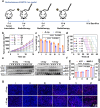Programmable melanoma-targeted radio-immunotherapy via fusogenic liposomes functionalized with multivariate-gated aptamer assemblies
- PMID: 38866788
- PMCID: PMC11169524
- DOI: 10.1038/s41467-024-49482-9
Programmable melanoma-targeted radio-immunotherapy via fusogenic liposomes functionalized with multivariate-gated aptamer assemblies
Abstract
Radio-immunotherapy exploits the immunostimulatory features of ionizing radiation (IR) to enhance antitumor effects and offers emerging opportunities for treating invasive tumor indications such as melanoma. However, insufficient dose deposition and immunosuppressive microenvironment (TME) of solid tumors limit its efficacy. Here we report a programmable sequential therapeutic strategy based on multifunctional fusogenic liposomes (Lip@AUR-ACP-aptPD-L1) to overcome the intrinsic radio-immunotherapeutic resistance of solid tumors. Specifically, fusogenic liposomes are loaded with gold-containing Auranofin (AUR) and inserted with multivariate-gated aptamer assemblies (ACP) and PD-L1 aptamers in the lipid membrane, potentiating melanoma-targeted AUR delivery while transferring ACP onto cell surface through selective membrane fusion. AUR amplifies IR-induced immunogenic death of melanoma cells to release antigens and damage-associated molecular patterns such as adenosine triphosphate (ATP) for triggering adaptive antitumor immunity. AUR-sensitized radiotherapy also upregulates matrix metalloproteinase-2 (MMP-2) expression that combined with released ATP to activate ACP through an "and" logic operation-like process (AND-gate), thus triggering the in-situ release of engineered cytosine-phosphate-guanine aptamer-based immunoadjuvants (eCpG) for stimulating dendritic cell-mediated T cell priming. Furthermore, AUR inhibits tumor-intrinsic vascular endothelial growth factor signaling to suppress infiltration of immunosuppressive cells for fostering an anti-tumorigenic TME. This study offers an approach for solid tumor treatment in the clinics.
© 2024. The Author(s).
Conflict of interest statement
The authors declare no competing interests.
Figures








Similar articles
-
Nanoradiosentizers with X ray-actuatable supramolecular aptamer building units for programmable immunostimulatory T cell engagement.Biomaterials. 2025 Apr;315:122924. doi: 10.1016/j.biomaterials.2024.122924. Epub 2024 Oct 29. Biomaterials. 2025. PMID: 39489019
-
Radiation-activated PD-L1 aptamer-functionalized nanoradiosensitizer to potentiate antitumor immunity in combined radioimmunotherapy and photothermal therapy.J Mater Chem B. 2024 Dec 4;12(47):12220-12231. doi: 10.1039/d4tb01831a. J Mater Chem B. 2024. PMID: 39420720
-
Reprogramming of radiation-deteriorated TME by liposomal nanomedicine to potentiate radio-immunotherapy.J Control Release. 2025 Jul 10;383:113792. doi: 10.1016/j.jconrel.2025.113792. Epub 2025 Apr 29. J Control Release. 2025. PMID: 40311685
-
Multifunctional Immunoliposomes Combining Catalase and PD-L1 Antibodies Overcome Tumor Hypoxia and Enhance Immunotherapeutic Effects Against Melanoma.Int J Nanomedicine. 2020 Mar 10;15:1677-1691. doi: 10.2147/IJN.S225807. eCollection 2020. Int J Nanomedicine. 2020. PMID: 32214807 Free PMC article.
-
Augmenting Anticancer Immunity Through Combined Targeting of Angiogenic and PD-1/PD-L1 Pathways: Challenges and Opportunities.Front Immunol. 2020 Nov 5;11:598877. doi: 10.3389/fimmu.2020.598877. eCollection 2020. Front Immunol. 2020. PMID: 33250900 Free PMC article. Review.
Cited by
-
Aptamers in Combination Therapies for Enhanced Radiosensitization in Cancer.Iran J Biotechnol. 2025 Jan 1;23(1):e4032. doi: 10.30498/ijb.2025.491856.4032. eCollection 2025 Jan. Iran J Biotechnol. 2025. PMID: 40463944 Free PMC article. Review.
-
Trivalent Disulfide Unit-Masked System Efficiently Delivers Large Oligonucleotide.Molecules. 2024 Sep 5;29(17):4223. doi: 10.3390/molecules29174223. Molecules. 2024. PMID: 39275071 Free PMC article.
References
MeSH terms
Substances
Grants and funding
- 32122048, 11832008, 92059107, 51825302/National Natural Science Foundation of China (National Science Foundation of China)
- 82272755/National Natural Science Foundation of China (National Science Foundation of China)
- cstc2021ycjh-bgzxm0124, cstb2022nscq-msx0488/Chongqing Science and Technology Commission (Chongqing Science and Technology Commission, Chongqing People's Municipal Government)
- 2022NSCQ-MSX0706/Chongqing Science and Technology Commission (Chongqing Science and Technology Commission, Chongqing People's Municipal Government)
LinkOut - more resources
Full Text Sources
Medical
Research Materials
Miscellaneous

